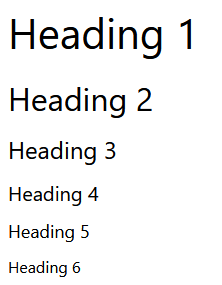There are many tags available in HTML. Here you will learn about common tags that you'll use as a developer.
Headings
Headings allow you to display titles and subtitles on your webpage.
<body>
<h1>Heading 1</h1>
<h2>Heading 2</h2>
<h3>Heading 3</h3>
<h4>Heading 4</h4>
<h5>Heading 5</h5>
<h6>Heading 6</h6>
</body>
Paragraphs
Paragraphs contain text content.
12345
This paragraph contains a lot of lines but they are ignored.
The following displays in the web browser:
Paragraph style displayed in browser
Note that putting content on a new line is ignored by the web browser.
Line Breaks
As you've learned, line breaks in the paragraph tag line are ignored by HTML. Instead, they must be specified using the
tag. The
tag does not need a closing tag.
12345
This paragraph
contains a lot of lines
and they are displayed.
The following displays in the web browser:
Line breaks displayed in browser
Strong
Strong tags can be used to indicate that a range of text has importance.
123
No matter how much the dog barks: don't feed him chocolate.
The following displays in the web browser:
Text with strong tag displayed in browser
Bold
Bold tags can be used to draw the reader's attention to a range of text.
123
The primary colors are red, yellow and blue.
The following displays in the web browser:
Bold text displayed in browser
The following displays in the web browser:
Text with strong tag displayed in browser
Bold tags should be used to draw attention but not to indicate that something is more important. Consider the following example:
1
The three core technologies of the Internet are HTML, CSS and Javascript.
The following displays in the web browser:
Bold text displayed in browser
Emphasis
Emphasis tags can be used to add emphasis to text.
123
Wake up now!
The following displays in the web browser:
Text with emphasis tag displayed in browser
Italics
Italics tags can be used to offset a range of text.
123
The term HTML stands for HyperText Markup Language.
The following displays in the web browser:
Italic text displayed in browser
Emphasis vs. Italics
By default both tags will have the same visual effect in the web browser. The only difference is the meaning.
Emphasis tags stress the text contained in them. Let's explore the following example:
1
I really want ice cream.
The following displays in the web browser:
Text with emphasis tag displayed in browser.
Italics represent off-set text and should be used for technical terms, titles, a thought or a phrase from another language, for example:
1
My favourite book is Dracula.
The following displays in the web browser:
Italic text displayed in browser
Screen readers will not announce any difference if an italics tag is used.
Lists
You can add lists to your web pages. There are two types of lists in HTML.
Lists can be unordered using the
- tag. List items are specified using the
- tag, for example:
123456
- Tea
- Sugar
- Milk
This displays in the web browser as:
Bullet style displayed in the browser img10
Lists can also be ordered using the- tag. Again, list items are specified using the
- tag.
12345
- Rocky
- Rocky II
- Rocky III
This displays as the following in the web browser.
Numbered list style displayed in browser img11
tag defines a content division in a HTML document. It acts as a generic container and has no effect on the content unless it is styled by CSS.
Div tags
AThe following example shows a
element that contains a paragraph element:123
This is a paragraph inside a div
This displays as the following in the web browser.
Div displayed in browser img12
It can be nested inside other elements, for example:12345
<p>This is a paragraph inside a div that’s inside another div</p>This displays in the web browser as:
Div inside a dive displayed in browser
As mentioned, the div has no impact on content unless it is styled by CSS. Let’s add a small CSS rule that styles all divs on the page.Don't worry about the meaning of the CSS just yet, you'll explore CSS further in a later lesson. In summary, you're applying a rule that adds a border and some visual spacing to the element.
1234567891011
div {
border: 1px solid black;
padding: 2px;
}<p>This is a paragraph inside stylized divs</p>This displays in the web browser as:
Paragraph in stylized div displayed in browser img13
Div elements are an important part of building webpages. More advanced usage of div elements will be explored in another course.Comments
If you want to leave a comment in the code for other developers, it can be added as:The comment will not be displayed in the web browser.




Top comments (0)